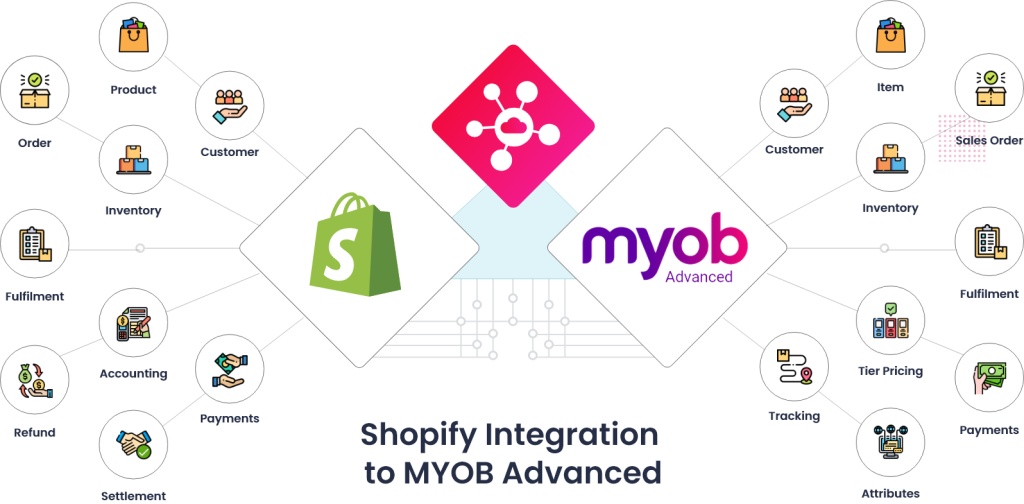In the fast-paced world of eCommerce, there’s no room for inefficiency.
That’s why integrating your Shopify store with a robust accounting and enterprise management system like MYOB Advanced is a game-changer.
But, what does it really take to integrate these two powerhouses of eCommerce and accounting?
This comprehensive guide aims to demystify the process, laying out each step in detail, including technical nuances.
Why Integrate Shopify with MYOB Advanced?
Uninterrupted Stock Updates
Imagine never worrying about the dreaded ‘Out of Stock’ tag again because your inventory is updated in real-time across all channels.
Automated Financials
Automatically sync your Shopify sales, expenses, and tax records into MYOB Advanced, making end-of-month accounting a breeze.
Tailored Customer Experiences
With your CRM integrated into your eCommerce system, your customers can enjoy a highly personalised shopping experience.
Streamlined Operations
Bypass the tedium of manual data entry, avoid duplication errors, and reduce administrative overhead.
What to Consider Before Taking the Leap
Budget & Resources
Allocate budget for the integration software, consulting fees, and any potential downtime during the integration process.
Data Compatibility
Ensure that your existing data in Shopify is in a format compatible with MYOB. You may require data transformation services.
Software Updates
Both Shopify and MYOB Advanced have frequent updates. Make sure your integration is future-proof to handle these.
Security Protocols
Implementing HTTPS, SSL, and data encryption is non-negotiable to protect against data breaches.
Technical Pre-requisites
Understanding APIs
Both Shopify and MYOB Advanced offer robust APIs for data integration:
- Shopify API: RESTful, GraphQL
- MYOB Advanced API: Typically RESTful
Middleware or Direct Connection
You can choose between middleware solutions like Zapier, or a direct API-to-API connection, based on your requirements.
Hosting Environment
MYOB Advanced is typically cloud-hosted, and Shopify is a SaaS platform. Ensure your network can support the data transfer loads.
Step-by-Step Integration Guide
Phase 1: Initial Set-Up
- API Configuration in Shopify: Navigate to
Admin -> Apps -> Manage private apps -> Create new private appin Shopify. - API Setup in MYOB: Head over to
Configuration -> Web Services -> Web APIin MYOB.
Phase 2: Data Synchronization
- Inventory Management: Automate the sync of product data from MYOB to Shopify.
# Python script to sync inventory
import requestsshopify_api = “https://your-shop-name.myshopify.com/admin/api/2021-07/products.json”
myob_api = “https://api.myobadvanced.com/api/inventory”
myob_response = requests.get(myob_api)
myob_data = myob_response.json()
shopify_payload = {‘product’: myob_data}
shopify_response = requests.post(shopify_api, json=shopify_payload)
- Order Management: Whenever a new order comes into Shopify, it should automatically create a sales order in MYOB.
// Node.js example to push order data
const axios = require('axios');try {
const response = await axios.post(‘https://api.myobadvanced.com/api/salesorder’, orderData);
console.log(`Order sync status: ${response.status}`);
} catch (error) {
console.error(`Error syncing order: ${error}`);
}
}
Phase 3: Rigorous Testing
- Creating a Staging Environment: Clone your live Shopify and MYOB setups to run tests without affecting live operations.
Shell command to clone Shopify store
shopify clone --store=your-live-store.myshopify.com --password=your-api-password
- Testing Data Integrity: Before going live, validate the data in both systems to ensure accuracy and completeness.
-- SQL query to validate data
SELECT COUNT(*) FROM shopify_orders WHERE order_id NOT IN (SELECT order_id FROM myob_orders);
Phase 4: Monitoring and Troubleshooting
- Logs and Alerts: Implement real-time monitoring to catch and report any data inconsistencies or syncing errors.
- User Training: Conduct in-depth training sessions for your team to understand the newly integrated system.
Common Pitfalls and How to Avoid Them
API Rate Limiting
Beware of API rate limits, particularly during peak sales seasons. Use retry mechanisms and queue systems to tackle this.
Inaccurate Data Mapping
One of the biggest hurdles is ensuring that your Shopify data fields match up with those in MYOB. Create a detailed mapping table to avoid this issue.
System Failures
Have a backup plan. Use fallback mechanisms like saving data temporarily in a queue to be processed later in case of a system failure.
Conclusion
Integrating your Shopify store with MYOB Advanced is not a decision to be taken lightly, but the operational efficiencies and customer satisfaction gains make it a worthwhile investment.
This comprehensive guide aims to prepare you for the journey ahead, providing you not just with the steps but also the technical nuances involved in such an integration.
So go ahead, take the plunge and supercharge your eCommerce operations.







